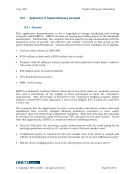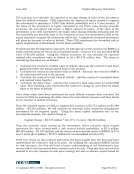June 2007 Capital Adequacy Extension © Copyright 2007, CCRO. All rights reserved. Page 76 of 92 contractual, but a posting of assurance could occur in order to continue doing business even if a contract did not require payment. In this case, the business mode for an organization changes when management is required to make decisions on whether to continue doing business with a counterparty or post assurance. Companies can use an expected and extreme scenario in modeling adequate assurance and disclose their assumptions. The expected scenario would be contractual, and the extreme scenario would include contractual as well as assurance required to continue business. This can be an extensive exercise for an organization, as all contracts would need to be reviewed in order to evaluate exposure under the two scenarios. • Negative MTM on all contracts - The margin required is equal to the negative MTM on previously non-margined positions. Even though a contract is may not require margining, counterparties may request adequate assurance to perform because they lack confidence in the company’s financial stability. In this case, management intervention is key in determining the amount of adequate assurance. Furthermore, the level of subjectivity increases in modeling impact on cash flow. Management may decide not to pay adequate assurance and discontinue future business, pay a portion of adequate assurance, or pay all. A range of adequate assurance scenarios be estimated with an expected and extreme case. • Net A/P Prepayment - A/P may be accelerated and prepayments required on physical deals not covered under master netting agreements. Given loss of confidence in financial stability or a down grade event, a company may be requested to prepay on amounts billed and not paid and for physical energy delivered but not yet billed. This can be as much as 60 days of notional value of settlements outstanding for net payables. The company most likely would not receive cash or cash equivalents for net receivables positions due it. • Specific Contractual Requirements - In a trigger event, contracts may require specific adequate assurance. For example, a pipeline or storage facility may require acceleration of demand payments for adequate assurance even though the position is in the money or gas is in inventory. 8.6. Debt / Equity Trigger Violation of a company’s financial debt covenants or equity trigger events may contribute to an increase in contingent liquidity. Most companies have worked toward eliminating contractual language that causes these trigger events in an effort to reduce liquidity requirements. If these contractual events do exist, they should be included in contingent liquidity calculations and disclosure. 8.7. Credit / Counterparty Terminations / Defaults Cash flow can be lost on replacement value of contracts due to a default event. For example, a company has an in-the-money (positive MTM) position with a counterparty,
Purchased by unknown, nofirst nolast From: CCRO Library (library.ccro.org)




























































































